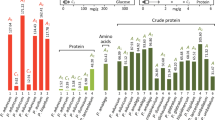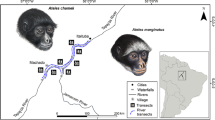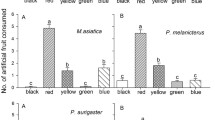Summary
We compared the feeding behaviour of two groups of captive Blackcaps (Sylvia atricapilla) on a mixed diet consisting of an insect diet and ripe or unripe fruits. Unripe Black Elder (Sambucus nigra) fruits have lower nutritional values, especially for protein, than ripe fruits. We tested the non exclusive hypotheses that birds increase their food intake and/or their digestive efficiencies when feeding on the low quality resource of unripe fruits. Birds fed readily on unripe fruits even when the insect diet was providedad libitum. With respect to food intake, birds consuming unripe fruits always had a lower fruit intake and higher intake of the insect diet than birds feeding on ripe fruits. Thus, the intake of unripe fruits is constrained, probably owing to the accumulation of deterrent fruit compounds. When the insect diet was reduced to 45 % of the birds’ad libitum intake, individuals consuming unripe fruits lost 5 % body mass, while those consuming ripe fruits maintained constant body mass. The mean difference in daily gross caloric intake between the two groups was only 4 kJ. Differences in body mass development are explainable by the different digestibility of ripe and unripe fruits. At the same caloric gross intake, birds feeding for 12 days on unripe fruits lost less body mass (5 %) than birds feeding newly on unripe fruits (16 %). We suggest that an increase in digestive efficiencies of birds being accustomed to this diet causes the difference in body mass development.
Zusammenfassung
Der Verzehr unreifer Früchte durch frugivore Vögel ist v. a. in Zeiten von Nahrungsknappheil beobachtet worden. Wir untersuchten die Ernährungsstrategien von zwei Gruppen von Mönchsgrasmücken, die sich von einem gemischtem Futter bestehend aus einem Insektenfutter und unreifen oder reifen schwarzen Holunderbeeren (Sambucus nigra) ernährten. Reife Früchte des schwarzen Holunders haben einen höheren Nährstoffgehalt als unreife Beeren, dies betrifft v. a. den Proteingehalt. Es wurden zwei sich nicht ausschließende Hypothesen getestet, dass Vögel entweder ihre Nahrungsaufnahme und/oder ihre Nahrungsverwertung erhöhen, wenn sie sich von unreifen Früchten als qualitativ geringe Futterquelle ernähren. Die Vögel fraßen unreife Früchte auch, wenn das zusätzliche Insektenfutterad libitum zur Verfügung stand. Vögel, die unreife Früchte fraßen, nahmen in je dem Versuchsstadium weniger Früchte und mehr Insektenfutter auf als diejenigen, die sich von reifen Früchten ernährten. Die Aufnahme unreifer Früchte ist wahrscheinlich durch die schnelle Akkumulation belastender sekundärer Pflanzenstoffe eingeschränkt, die den Konsum von unreifen Früchten verhindern sollen. Bei der Reduktion des zusätzlichen Insektenfutters auf 45 % derad libitum Aufnahme, verlor die Gruppe, die sich von unreifen Früchten ernährte, 5 % Gewicht über vier Tage, während Vögel, die reife Früchte fraßen, ihr Gewicht hielten. Dabei nahmen Individuen der letzten Gruppe durchschnittlich nur 4 kJ mehr pro Tag auf als Vögel der anderen Gruppe. Die unterschiedliche Gewichtsentwicklung ist durch Unterschiede in der Verwertung reifer und unreifer Früchte erklärbar. An unreife Früchte gewöhnte Vögel verloren weniger Gewicht (5 %) bei einem Futter, das weitgehend aus unreifen Früchten bestand, als Vögel, die zum ersten Mal mit unreifen Früchten gefüttert wurden (16 %). Da sich die Energie- und Nährstoffaufnahme während und vor dem Vergleich beider Gruppen nicht unterschied, nehmen wir an, dass eine erhöhte Verdauungseffizienz die unterschiedliche Gewichtsentwicklung bedingt.
Similar content being viewed by others
References
Bairlein, F. (1986): Ein standardisiertes Futter für Ernährungsuntersuchungen an Singvögeln. J. Ornithol. 127: 338–340.
Bairlein, F. (1987): Nutritional requirements for maintenance of body weight and fat deposition in the long-distance migratory Garden Warbler Sylvia borin (Boddaert). Comp. Biochem. Physiol. 86A: 337–347.
Bairlein, F. (1988): Zur Nahrungswahl der GartengrasmückeSylvia borin: Ein Beitrag zur Bedeutung der Frugivorie bei omnivoren Singvögeln. Proc. Int. 100 DO-G Meeting, Current Topics Avian Biol.: 103–110.
Bairlein, F. (1990): Nutrition and food selection in migratory birds. In. Gwinner, E. (Ed.): Bird migration: The Physiology and Ecophysiology: 198–213. Berlin.
Bairlein, E (1991): Nutritional adaptations to fat deposition in the long-distance migratory Garden WarblerSylvia borin. Acta XX Congr. Internat. Ornithol. 2149–2158.
Bairlein, F. (1999): Energy and nutrient utilisation efficiencies in birds- A review. Proc. Int. Ornithol. Congr., Durban: 2221–2246.
Bairlein, F. & Simons, D. (1995): Nutritional adaptations in migrating birds. Israel J. Zool. 41: 357–367.
Berthold, P. (1976): Animalische und vegetabilische Ernährung omnivorer Singvogelarten: Nahrungsbevorzugung, Jahresperiodik der Nahrungswahl, physiologische und ökologische Bedeutung. J. Ornithol. 113: 170–190.
Bondi, A. A. (1987): Animal nutrition. New York.
Cipollini, M. L. & Levey, D. J. (1997): Secondary metabolites of fleshy vertebrate-dispersed fruits: Adaptive hypotheses and implications for seed dispersal. Amer. Nat. 150: 346–372.
Foster, M.S. (1977): Ecological and nutritional effects of food scarcity on a tropical frugivorous bird and its fruit source. Ecology 58: 73–85.
Galetti, M., Ziparro, V. B. & Morellato, P. C. (1999): Fruiting phenology and frugivory on the palmEuterpe edulis in a lowland Atlantic forest of Brazil. Ecotropica 5: 115–122.
García, D., Zamora, R., Gómez, J. M. & Hodar, J. A. (1999): Bird rejection of unhealthy fruits reinforces the mutualism between juniper and its avian dispersers. Oikos 85: 536–544.
Glutz von Blotzheim, U. & Bauer, K. M. (1991): Handbuch der Vögel Mitteleuropas. Bd. 12. Passeriformes. Wiesbaden.
Goldstein, J. L. & Swain, T. (1963): Changes in tannins in ripening fruits. Phytochemistry 2: 371–383.
Guglielmo, C., Karasov, W. H. G. & Jakubas, W. J. (1996): Nutritional costs of a plant secondary metabolite explain the selective foraging by ruffed grouse. Ecology 77: 1103–1115.
Izhaki, I. & Safriel, U. N. (1989): Why are there so few exclusively frugivorous birds? Experiments on fruit digestibility. Oikos 54: 23–32.
Jakubas, W. J., Gullion, G. W. & Clausen, T. P. (1989): Ruffed Grouse feeding bel-kaviour and its relationship to secondary metabolites of quaking aspen flower buds, J. Chem. Ecol. 15: 1899–1917.
Karlson, P. (1972): Biochemie, 8th ed. Stuttgart.
Koenig, W. D. (1991): The effects of tannins and lipids on digestion of acorns by acorns woodpeckers. Auk 108:79–88.
Leck, C. F. (1972): Seasonal changes in feeding pressures of fruit- and nectar-eating birds in Panamá. Condor 74: 54–60.
Levey, D. J. (1987): Sugar-tasting ability and fruit selection in tropical fruit-eating birds. Auk 104: 173–179.
Poston, M. E. & Middendorf, G. A. (1988): Maturation characteristics ofRubus pennsylvanicus fruits: are red and black the same? Oecologia 77: 69–72.
Provenza, F. D., Burritt, E. A., Clausen, T. P., Byrant, J. R., Reichardt, P. B. & Distel, R. A. (1990): Conditioned flavor aversion: a mechanism for goats to avoid condensed tannins in blackbrush. Amer. Nat. 136: 801–826.
Robbins, C. T., Hanley, T. A., Hagerman, A. E., Hjeljord, O., Schwartz, C. C. & Mautz, W. W. (1987): Role of tannins in defending plants against ruminants: Reduction in protein availability. Ecology 68: 98–107.
Schaefer, H. M., Schmidt, V. & Wesenberg, J. (in press): Vertical stratification and caloric content of fleshy fruit production and standing crop in a tropical lowland forest. Biotropica.
Simons, D. & Bairlein, F. (1990): Neue Aspekte zur zugzeitlichen Frugivorie der Gartengrasmücke (Sylvia borin). J. Ornithol. 131: 381–402.
Winkler, H. & Leisler, B. (1999): Exploration and curiosity in birds: Functions and mechanisms. Proc. 22 Int. Ornithol. Congr., Durban: 915–932.
Witmer, M. C. & Van Soest, P. J. (1998): Contrasting digestive strategies of fruit-eating birds. Functional Ecology 12: 728–741.
Author information
Authors and Affiliations
Rights and permissions
About this article
Cite this article
Schaefer, H.M., Schmidtt, V. Feeding strategies and food intake of Blackcaps (Sylvia atricapilla) consuming ripe or unripe fruits and insects. J Ornithol 143, 341–350 (2002). https://doi.org/10.1007/BF02465484
Accepted:
Published:
Issue Date:
DOI: https://doi.org/10.1007/BF02465484




